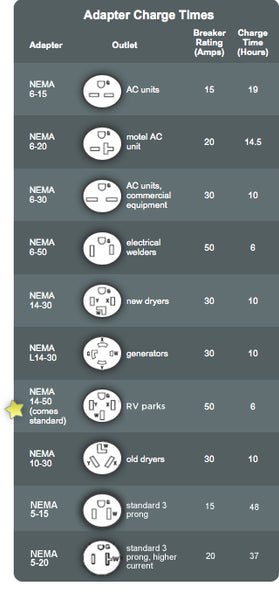Don said:
.....The circuit breaker should never be sized larger than the capacity of the wire on the appliance you're feeding, otherwise it could be possible to melt or burn that lighter gauge wire in the event of a short circuit before your huge breaker will trip. If your EVSE is rated for 20 amps, it probably has a 10 or 12 gauge wire attached to it's plug and you cannot use a 50 amp breaker to feed a 10 or 12 gauge wire. If you intend to use that outlet only for the EVSE, you really should replace your breaker with the smaller 25 amp
......Don
Hi Don.
Don said:
......The circuit breaker should never be sized larger than the capacity of the wire on the appliance you're feeding, otherwise it could be possible to melt or burn that lighter gauge wire in the event of a short circuit before your huge breaker will trip......Don
Hi Don.
You’re quite right, to my surprise, that Clipper Creek more or less insists that one put 25 amp breakers upstream from their L2 charger to protect it and the car.
I’m not going to try to second guess the professional electronics engineers who made that design decision (rather than putting a 24 amp fuse or breaker right in their charger) but it seems an odd way to do it.
In contrast to that I just talked to Leviton tech support. They said for their 002-EVC11-300 12 amp level one charger they want a 15 amp OR HIGHER dedicated circuit. For their 30 amp level 2 “you would want a 40amp or higher rated circuit” . I specifically grilled them along the lines of “no problem if the circuit and breaker is rated even higher than 40 amps, right?” … and they concurred.
What’s more at this moment my stock MiEV level one charger (which says right on itself draws 8 amps) is plugged into a receptacle with a breaker rated at 15 amps. In fact, right in the MiEV manual it specifically says to plug it into a receptacle rated at “15amps or more..”
So we have some sort of misunderstanding between us::
Seem to me that it is actually common to have devices plugged into circuits/receptacles that have breakers larger capacity than the device plugged in and even higher thanthe device's own wiring. The device, unless something's broken/shorted should never draw the full capacity of the breaker.
I'm sitting next to a lamp whose current draw is about 0.5 amps (rated to have a bulb up to 60 watts in it).
Its power cord is proportionally light … doubt it could handle more than 8 amps max if even that. Yet it’s plugged into a receptacle backed by a 15amp breaker.
Look at this list of typical appliance amp ratings:
Refrigerator 3.5
Iron 8
Electric blanket 2
Hair dryer (1500 watts) 13
Hair dryer (400 watts) 3.5
Curling iron 0.7
TV .5-1.0
VCR 0.2
Computer 2
Every single one of those in my house (and I bet yours too) is plugged into a receptacle whose breaker
is rated HIGHER than the appliance. If not, the breaker would trip the very first time you turned on the appliance. The breaker limit is designed to protect the house wiring between it and the appliance, not the appliance (with the clipper creek requirement being the exception, not the rule. . Many appliances (such as a VCR) have fuses or breakers built in to protect them
selves.
Maybe what you’re referring to is one should never install a breaker rated higher than the wiring between the breaker and the wall receptacle? That I agree on.
Are we getting on the same page here?
Alex
























